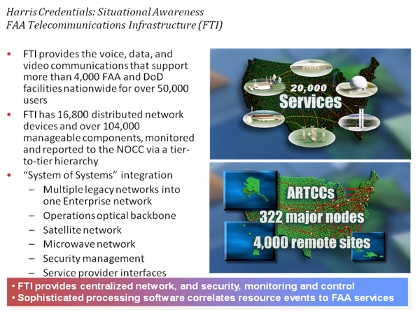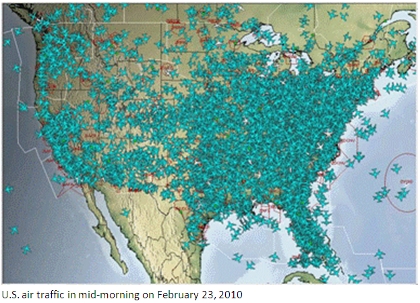A Look at Commercial Aviation’s Cornerstone Operations Control System to Provide Regional and Nationwide Operations Management for Electric Power
I want to take this opportunity to provide our web site visitors and our Market Trends Digest readers (upcoming spring 2010 edition) with some summary information about what we believe to be one of the country’s most advanced implementations of something akin to what we have been discussing for the past few years as an emerging requirement for the national’s smarter electric grid operations. The FAA Telecommunications Infrastructure System (or FTI) is perhaps the best example I have seen of a system of effective management tools for nationwide situational awareness and visualization so vital to the daily operation of a communications-centric community as air traffic.
Recently I had an opportunity to tour the FAA’s Telecommunications Infrastructure control center. I came away from this “system of systems” quite impressed, this after visits to perhaps 60-65 major utility and pipeline operations control centers in several countries in the course of my career. In fact, this particular system is probably the largest (encompassing the entire United States) and without a doubt, one of the more sophisticated and most complex communications control and network management systems in existence.
The complex engineering design, development, implementation and operation of the current FTI system is the result of a multi-year partnership between the FAA and Harris Corporation. Harris has been a major participant –albeit relatively little-known outside of its customer base – for decades in providing communications assurance for the world’s space programs and for various related complex communications systems environments for critical public safety, national defense, and space exploration environments.
First, we need to know more about Harris itself, a firm I call the “gem” of the U.S. Space Coast. Harris Corporation is an international communications and information technology company specializing in complex systems integration activities, serving government and commercial markets in more than 150 countries. Headquartered in Melbourne, Florida, the company has approximately $5 billion of annual revenue and more than 15,000 employees — including nearly 7,000 engineers and scientists. Harris is dedicated to developing best-in-class assured communications® products, systems, and services.
Harris, in a nutshell, is a highly capable (but very low-key) and well-regarded company, known around the world to its target markets for unique skills at engineering, construction and operation of hardened wide-range systems and devices designed for difficult (and harsh) communications environments such as outer space and congested inner urban areas. For several years up through the 1990’s, Harris had been a control systems integration specialist serving electric power and transportation SCADA and was a partner with General Electric prior to GE’s acquisition of the Harris control systems business.
So what makes the Harris-managed FTI system so unique and why should the electric power community or other critical infrastructure segment care? I visited the FTI operations center twice recently, and left the site more impressed after each visit. The system, as presently configured, ensures communication integrity, availability, and security for the nation’s commercial aviation activities, under the aegis of the FAA. The FTI center has been in operation for six years now, and remains a vital, leading edge example of what FERC and NERC have been seeking for “situational awareness”, “visualization” and highly assured activity in control centers operated by the nation’s ISO’s and large transmission utilities.
I have this sense that other critical infrastructure segments have similar requirements for communications assurance and situational awareness on a broad scale as well as do members of the electric power community. The FAA has some of the very same concerns for situational awareness, cyber security, and visualization that are now being required of the nation’s electric power industry. Further, segregation of user traffic and management traffic within the network allows integrated situational awareness without compromising operational data.
The technology transferability and application “fit” of the FTI system to the electric power industry seems very good from my vantage point. More information can be made available in order to gain a clearer understanding of the capabilities and advanced features of the system, and convey the transferability of this advanced technology to enable a region wide or nationwide communications management capability.
Below are a few excerpts from a full presentation developed by Harris Corporation for use with officials like many of our readers who are also leaders in the planning, management and operation of the nation’s bulk electric power industry. Simply because of the “assurance” side of the communications network management system involved, we will use discretion and simply state that the work effort, the operational team, the secure aspects of the operations center, all provide a true basis for migration of FTI-like capabilities to the electric power community either at a national or regional level. To do so would provide the kind of sophisticated coordination the industry requires for near and mid-term regional, and even national, electric power communications assurance. Take a quick read of the company’s slides adopted for this article, and you will see the resemblance of what the FAA has required and what the electric power industry should be able to attain.
The architecture behind both the network communications operations control center and the co-located network security operations control center take advantage of 21st century developmental tools and cyber protection methodologies. FTI services four thousand sites and 50,000 users.
Following is a list of nine key critical requirements established for the FAA Telecommunications Infrastructure (FTI) system and operational infrastructure.
- An architecture tailored to mission critical priorities: (“AIC” not “CIA”)
- (Availability, Integrity, and Confidentiality) instead of (Confidentiality, Integrity, and Availability)
- Backbone = .9999971 availability for on-net services
- FAA Certified System of Systems
- Topology Optimization for bandwidth consolidation
- Value-Added Operational Infrastructure
- Trusted Gateway Connections to the Internet
- Network service model partitioned for availability, reliability, and security
- Carrier Diversity (Multiple telecoms carriers, multiple methodologies)
These look quite similar to some of the requirements we now see coming to the fore front in the electric power industry.
In summary, a number of industry analysts concerned with operational security issues such as visualization and situational awareness requirements view the Harris FTI system as the advanced version of an enabling “engine” whose root technology can be modified for other applications. The transferability of this advanced technology platform could enable a region-wide, for an ISO, or nationwide communications management capability for NERC or FERC or DoE.
One last thought on complexity of mission: The FAA web site informs us that there are about 2,000 – 7,000 aircraft in the air over the United States at any given time. Just imagine the sophistication of a system of systems to manage and securely control the flow of voice and data communications to help make the U.S.’ air traffic control system the safest in the world. Now imagine having a system that can help manage and secure voice and data communications to enable the efficient and reliable flow of electricity on the emerging smart grid.



 summary reviews and highlights from completed studies
summary reviews and highlights from completed studies
